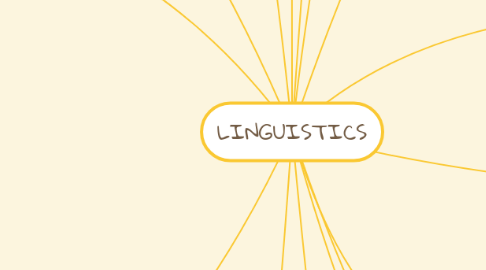
1. Tentative phrases
2. Accents
3. Phonology
4. Hypernymy
5. phonologicalistics
5.1. rhyme
5.1.1. assonance
5.2. allication
5.3. correlation of the sound form and meaning
6. The study of sound patterns languages
6.1. Phoneme
6.1.1. Smallest segment of sounds which can distinguish two words.
6.2. Allophone
6.2.1. A variant of phoneme in paerticular language
7. Complementary
8. Sociolinguistics
8.1. Dialect
8.1.1. Vocabulary
8.1.2. Sound
8.1.3. Syntax
8.2. Registers
8.2.1. Topic discussed
8.2.2. Formality of occasion
8.2.3. Medium used
8.2.3.1. Spoken
8.2.3.2. Written
8.2.3.3. Signed
8.3. High-density network
8.4. Social Networks
8.4.1. Low-density network
8.5. Language & Sex
8.5.1. Women
8.5.1.1. Question intonation
8.5.1.2. Commands=joint actions
8.5.2. Men
8.5.2.1. Straightforward
8.5.2.2. Insecure style
8.5.2.3. Direct orders
9. Semantics
9.1. Synonymy
9.2. Antonymy
9.2.1. Gradable
9.2.2. Relational
9.3. Ambiguity
9.3.1. Polysemy
9.3.2. Homonyms
9.3.3. Homophones
9.4. Hyponymy
9.5. Homographs
9.6. Metaphors
9.7. Componential Analysis
9.8. Prototypes
10. Pragmatic
10.1. Definition
10.1.1. The study of speaker meaning.
10.2. Context
10.2.1. Physical
10.2.2. Linguistic
10.2.3. Social
10.2.4. Epistemic
10.3. Speech Act
10.3.1. Indirect Speech Act
10.3.2. Direct Speech Act
10.4. Speech Act
10.4.1. Representative
10.4.2. Directive
10.4.3. Commisive
10.4.4. Expressive
10.4.5. Declaration
10.5. Grice's Maxim
10.5.1. Maxims of Quality
10.5.2. Maxims of Relevance
10.5.3. Maxims of Quantity
10.5.4. Maxims of Manner
10.6. Politeness
10.6.1. Face Threatening Act - On record - Off record
10.6.2. Face Saving Act - Positive politeness - Negative politeness
11. Morphology
11.1. Free morphemes
11.1.1. Lexical Morpheme
11.1.2. Functional Morpheme
11.2. Bound Morpheme
11.2.1. Derrivational Morpheme
11.2.2. Inflectional Morpheme
11.3. Word Formation Processes
11.3.1. Coinage
11.3.2. Blending
11.3.3. Compounding
11.3.4. Conversion
12. Phonetic & Phonology
12.1. Phonetic
12.1.1. The study of aounds and their priduction
12.1.1.1. Consonant
12.1.1.1.1. Place
12.1.1.1.2. Manner
12.1.1.2. Vowels
12.1.1.2.1. High
12.1.1.2.2. Mid
12.1.1.2.3. Low
12.1.1.2.4. Front
12.1.1.2.5. Lentral
12.1.1.2.6. Back
12.1.1.2.7. Dipththongs
12.1.1.2.8. Nazalitation
13. Syntax
13.1. Lexical/Content
13.2. Generative Grammar
13.3. Tree Diagram
13.4. Types of Sentences
13.4.1. Simple Sentences
13.4.2. Compound
13.4.3. Complex
13.4.4. Compound-Complex
14. psycholinguistics
14.1. language comprehension
14.1.1. understanding what other people say and write
14.2. language production
14.2.1. the production of spoken or written language
14.3. language acquistion
14.3.1. how people learn to speak and the mental processes involved
14.3.1.1. second language acquistion
14.3.1.2. the stages
14.3.1.2.1. cooing-6 months
14.3.1.2.2. babbling-9 months
14.3.1.2.3. one word utterances-12 months
14.3.1.2.4. telegraphist speech-2 years
14.3.1.2.5. normal speech-5 years
14.4. speech problems
14.4.1. slips of tongue
14.4.2. stuttering
14.4.3. aphasia
15. stylistics
15.1. lexical
15.1.1. connotations
15.1.1.1. expressive
15.1.1.2. evaluative
15.1.1.3. emotive
15.1.1.4. neologisms
15.1.1.5. their behavior
15.1.1.6. dialectal words
15.1.2. correlation of the message
15.2. functional
15.3. stylistics of encoding
15.3.1. figurative language
15.3.2. sound techniques
15.3.3. communicative situation
15.3.4. structural devices
15.3.5. irony
15.3.6. register
15.4. morphological
15.5. grammatical
15.5.1. syntactical
15.6. individual style study
15.6.1. studies the style of the author
